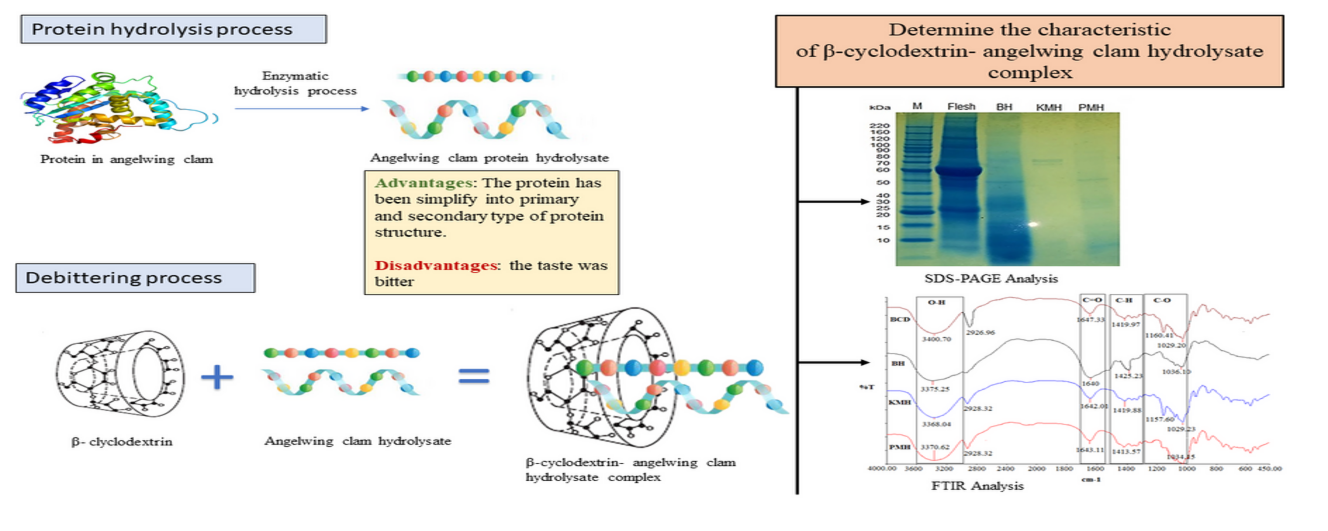Graphical Abstract

References
1.
Del Valle. E. (2004). Cyclodextrins and their uses: a
review. Process Biochemistry, 39: 1033-1046.
2.
Sambasevam, K. P., Sharifah,
M., Norazilawati, M. S. and Nor Atiqah,
I. (2013). Synthesis and characterization of the inclusion complex of
β-cyclodextrin and azomethine. International
Journal Molecular Science, 14: 3671-3682.
3.
Hou, L., Wang, J. and Zhang, D. (2013). Optimization
of debittering of soybean antioxidant hydrolysates with β-cyclodextrin
using surface response methodology. Journal
of Food Science and Technology 50: 521-527.
4.
Nazeer, R. A., Prabha, K. R., Divya
Kumar, N. S., Sampath, G. and Jai, R. (2011). Isolation of antioxidant peptides
from clam, Meretrix casta (Chemnitz). Journal of Food Science and Technology
50: 777-783.
5.
Normah, I. and Nurul Fasihah, R. (2014). Sensory, amino acids composition and flavour compounds of angelwing clam (Pholas
orientalis) hydrolysates produced using two
different enzymes. Science Letters, 8:1, 25-33.
6.
Normah, I. and Nurul Fasihah, R. (2017). Evaluation of β-cyclodextrin
masking effect on the bitterness of angelwing clam (Pholas orientalis) hydrolysate. International Food Research Journal,
24(4): 1500-1506.
7.
Szejtli J. (1998).
Introduction and general overview of cyclodextrin chemistry. Chemistry
Reviews, 98:1743-1753.
8.
Schmid G. (1989). Cyclodextrin glucanotransferse
production: yield enhancement by overexpression of cloned genes. Trends Biotechnologies, 7: 244-248.
9.
Normah, I and Nurul Fasihah, R. (2016). Bitterness and physichochemical
properties of angelwing clam (Pholas orientalis) hydrolysate. Malaysian Journal of Analytical Sciences, 20: 594-600.
10. Klompong, V., Benjakul, S., Kantachote, D and
Shahidi. (2007). Antioxidative activity and functional properties of protein hydrolysate of yellow stripe trevally
(Selaroids leptolepis)
as influenced by the degree of hydrolysis and enzyme type. Food Chemistry, 102: 317-327.
11. Diniz, F. M. and
Martin, A. M. (1997). Effects of the extent of enzymatic hydrolysis on the
functional properties of shark protein hydrolysate. Lebensmittel Wissenschaft and Technologies 30:
266-272.
12. Shahidi, F.,
Xiao-Qing, H. and Synowiecki, J. (1995). Production
and characteristics of protein hydrolysates from capelin (Mallotus
villosus). Food
Chemistry 53: 285-293.
13. Sathe, S. K. and Salunkhe, D. K. (1981). Functional properties of the Great
Northern bean (Phaseolus vulgaris L.) proteins: emulsion, foaming,
viscosity and gelation properties. Journal
of Food Science, 46: 71-74.
14. IBM Corporation (2011). IBM
SPSS Statistics for Windows, Version 20.0. Armonk, NY: IBM Corp.
15. Crupi, V., Ficarra, R.,
Guardo, M., Majolino, D., Stancanelli, R. and Venuti, V. (2007). UV-vis and FTIR-ATR
spectroscopic technique to study the inclusion complexes of genistein with
β-cyclodextrin. Journal of
Pharmaceutical and Biomedical Analysis, 44: 110-117.
16. Simon, B. W., Adi,
N. and Teti, E. (2011). Functional
interaction components of protein isolates and glucomannan in food bars by FTIR
and SEM studies. African Journal of Food
Science, 5: 12-21.
17. Robinson, N. C. and Tanford, C. (1975). The
binding of deoxycholate, triton X-100, sodium dodecyl sulfate, and
phosphatidylcholine vesicles to cytochrome b5. Biochemistry, 14: 369-378.
18. Aachmann, F.
L., Otzen, D. E., Larsen, K. L. and Wimmer, R. (2003). Structural background of
cyclodextrin-protein interactions. Protein
Engineering,16: 905-912.
19. Rozema, D
and Gellman, S. H. (1996). Artificial chaperone-assisted refolding of carbonicanhydrase. Biological
Chemistry, 271: 3478-3487.
20. Muo, X and Hua, Y. (2012).
Composition, structure and functional properties of protein concentrates and
isolates produced from walnut (Juglans regia L.). International Journal of Molecular Sciences, 13: 1561-1581.
21. Yin, Y. R., Liu, W. Q and Xiao, K.
J. (1996). The study of Sesame protein solubility and emulsification. Food Science, 17: 3-6.
22. Tang, L., Sun, J., Zhang, H. C., Zhang, C. S., Yu,
L. N. and Bi, J. (2012). Evaluation of
physicochemical and antioxidant properties of peanut protein hydrolysate. PLoS One 7(5): e37863.
23. Amiza, M.
A., Ow, Y. W. and Faazaz A. L. (2013).
Physicochemical properties of silver catfish (Pangasius sp.) frame
hydrolysate. International Food Research
Journal, 20(3):1255-1262.
24. Rahman, M. S. (2007). Hand book of food preservation. 2nd edition, Boca Raton, FL, USA, CRC Press: pp.
519.
25. Sanjoy Kumar D., Rajabalaya, R., Sheba, D., Nasimul, G., Jasmina, K and
Nanda, A. (2013). Cyclodextrins-the molecular container. Research Journal of Pharmaceutical, Biological and Chemical Sciences,
4: 1694-1720.
26. Chaplin, M. F. (2003). Fibre and water binding. Proceeding of Nutritional Society, 62: 223-227.
27. Popovic, l., Peričin, D., Vaštag, Z. and Popovic, S. (2011). Optimization of
enzymatic hydrolysis of cucurbitin using response
surface methodology: improvement of the functional properties. International Journal of Food, 7, 5:
1556-3758.
28. Kristinsson, H.
G. and Rasco, B. A. (2000). Fish protein hydrolysates:
Production, biochemical and functional properties. Critical Reviews in Food Science and Nutrition, 40: 43-81.
29. Mutilangi, W. A. M., Panyam, D. and Kilara, A. (1996).
Functional properties of hydrolysates from proteolysis of heat-denatured whey
protein isolate. Journal of Food Science,
61: 270-274.
30. Wagner, J. R., Sorgentini, D. A and Anon M. C.
(2000). Relation between solubility and surface hydrophobicity as an indicator of
modifications during preparation processes of commercial and laboratory-prepared
soy protein isolates. Journal of Agricltural Food
Chemistry, 48, 3159-3165.
31. Mentink, L.
(1999). β-cyclodextrin emulsion: Mechanism of emulsification and
application to the preparation of green metalworking fluids. Netherlands,
Springers: pp. 693-696.
32. Gbogouri, G.
A., Linder, M., Fanni, J, and Parmentier,
M. (2004). The influence of hydrolysis degree on the functional properties of
salmon byproducts hydrolysates. Journal
of Food Sciences, 69: 615-622.
33. Cho, D-Y., Jo, K., Cho, S. Y.,
Kim, J. M., Lim, K., Suh, H. J
and Oh, S. (2014). Antioxidant effect and functional properties of hydrolysates
derived from egg-white protein. Korean
Journal Food Sciences of Animal Resources, 34(3): 362-371.